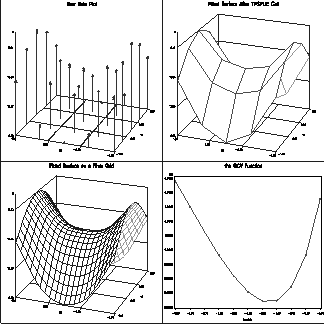| Language Reference |
| TPSPLNEV Call |
The TPSPLNEV subroutine evaluates the thin-plate smoothing spline (TPSS) at new data points. It is used after the TPSPLINE subroutine fits a thin-plate spline model to data.
The TPSPLNEV subroutine returns the following value:
- pred
is an
 vector of the predicated values of the TPSS fit evaluated at
vector of the predicated values of the TPSS fit evaluated at  new data points.
new data points.
The input arguments to the TPSPLNEV subroutine are as follows:
- xpred
is an
 matrix of data points at which the
matrix of data points at which the  is evaluated, where
is evaluated, where  is the number of new data points and
is the number of new data points and  is the number of variables in the spline model.
is the number of variables in the spline model. - x
is an
 matrix of design points that is used as an input of TPSPLINE call.
matrix of design points that is used as an input of TPSPLINE call. - coeff
is the coefficient vector returned from the TPSPLINE call.
See the previous section on the TPSPLINE call for details about the TSPLNEV subroutine.
As an example, consider the following data set, which consists of two independent variables. The plot of the raw data can be found in the first panel of Figure 23.224.
x={ -1.0 -1.0, -1.0 -1.0, -0.5 -1.0, -0.5 -1.0,
0.0 -1.0, 0.0 -1.0, 0.5 -1.0, 0.5 -1.0,
1.0 -1.0, 1.0 -1.0, -1.0 -0.5, -1.0 -0.5,
-0.5 -0.5, -0.5 -0.5, 0.0 -0.5, 0.0 -0.5,
0.5 -0.5, 0.5 -0.5, 1.0 -0.5, 1.0 -0.5,
-1.0 0.0, -1.0 0.0, -0.5 0.0, -0.5 0.0,
0.0 0.0, 0.0 0.0, 0.5 0.0, 0.5 0.0,
1.0 0.0, 1.0 0.0, -1.0 0.5, -1.0 0.5,
-0.5 0.5, -0.5 0.5, 0.0 0.5, 0.0 0.5,
0.5 0.5, 0.5 0.5, 1.0 0.5, 1.0 0.5,
-1.0 1.0, -1.0 1.0, -0.5 1.0, -0.5 1.0,
0.0 1.0, 0.0 1.0, 0.5 1.0, 0.5 1.0,
1.0 1.0, 1.0 1.0 };
y = {15.54, 15.76, 18.67, 18.50, 19.66, 19.80, 18.60, 18.52,
15.87, 16.04, 10.92, 11.14, 14.81, 14.83, 16.56, 16.44,
14.91, 15.06, 10.92, 10.94, 9.61, 9.65, 14.03, 14.03,
15.77, 16.00, 14.00, 14.03, 9.56, 9.58, 11.21, 11.09,
14.84, 14.99, 16.55, 16.51, 14.98, 14.72, 11.15, 11.17,
15.83, 15.96, 18.64, 18.56, 19.54, 19.81, 18.57, 18.61,
15.87, 15.90 };
Now generate a sequence of  from
from  to
to  so that you can study the GCV function within this range. Use the following statement:
so that you can study the GCV function within this range. Use the following statement:
lambda = T( do(-3.8, -3.3, 0.1) );
Use the following statement to do the thin-plate smoothing spline fit and returning the fitted values on those design points.
call tpspline(fit, coef, adiag, gcv, x, y, lambda);
The output from this call follows.
SUMMARY OF TPSPLINE CALL
Number of observations 50
Number of unique design points 25
Dimension of polynomial Space 3
Number of Parameters 28
GCV Estimate of Lambda 0.00000668
Smoothing Penalty 2558.14323
Residual Sum of Squares 0.24611
Trace of (I-A) 25.40680
Sigma^2 estimate 0.00969
Sum of Squares for Replication 0.24223
After this TPSPLINE call, you obtained the fitted value. The fitted surface is plotted in the second panel of Figure 23.224. Also in Figure 23.224, panel 4, you plot the GCV function values against lambda. From panel 2, you see that because of the spare design points, the fitted surface is a little bit rough. In order to study the TPSS fit  more closely, you can use the following statements to generate a more dense grid on
more closely, you can use the following statements to generate a more dense grid on  .
.
xGrid = T( do(-1, 1, 0.1) );
yGrid = T( do(-1, 1, 0.1) );
do i = 1 to nrow(xGrid);
x1 = x1 // repeat(xGrid[i], nrow(yGrid));
x2 = x2 // yGrid;
end;
xpred = x1 || x2;
Now you can use the function TPSPLNEV to evaluate  on this dense grid. Here is the statement:
on this dense grid. Here is the statement:
call tpsplnev(pred, xpred, x, coef);
The final fitted surface is plotted in Figure 23.224, panel 3.

Copyright © SAS Institute, Inc. All Rights Reserved.